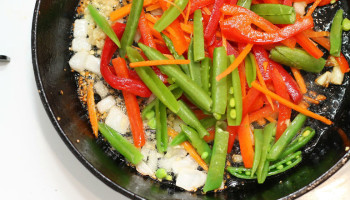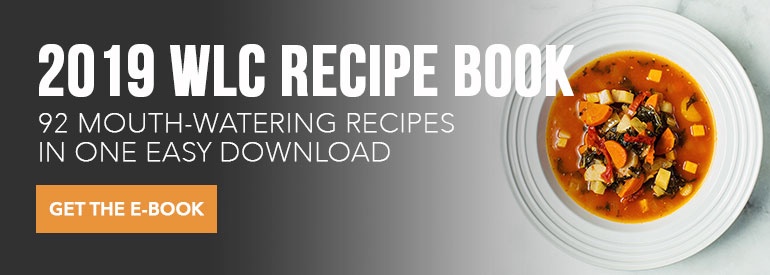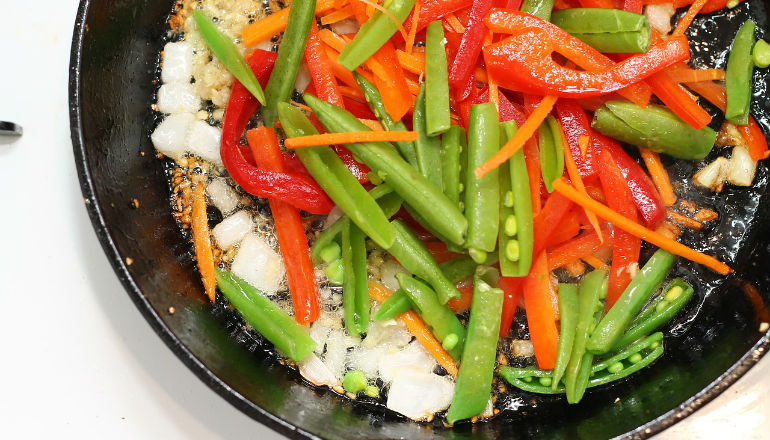 Reading Time: 10 minutes
Reading Time: 10 minutesThere are so many different types of fats and different ways they affect our systems when we consume them. These differences are even more enhanced when we look at the way these fats are produced, how refined they are, and how we use them for cooking.
Most of us understand the basics of which fats to consume, but when it comes to how to cook with fats and oils, things get more complicated.
Many of us think we are doing something healthy, when we are actually doing something that could be quite harmful for our health. This is because when fats are heated they become chemically altered and this, in turn, affects how our body handles them.
To help you avoid mistakes and learn how to cook with fats and oils in a healthy way, I’m going to explain the following:
- Smoking points and why not being aware of them can lead to danger.
- Which fats to use for cooking and which fats should be consumed raw and why.
- Fats that should be avoided regardless of their smoking points.
Fats 101
First a quick refresher on some things you most likely already know about fats:
Trans fats, partially hydrogenated fats, and fully hydrogenated fats are bad for us. These fats are found in deep fried foods and many baked goods such crackers and muffins. Manufacturers hydrogenate the oil because it prolongs the shelf life of processed foods. Partially hydrogenated soybean oil is one example we see often and it is widely used in nut butters, spreads, and creamers. Products such as margarine and shortenings are loaded with trans fats and should be avoided at all costs.
It’s generally regarded as a good idea to limit saturated animal fats, and enjoy a small amount of monounsaturated and polyunsaturated fats, such as oils we can add to our salads. Monounsaturated fats like olive oil are a good type of fat and good for our heart, along with polyunsaturated fats, like omega-3s, which can be found in fatty fish.
Understanding Smoking Points
Different fats have different smoking points — this is the temperature where the fats start to break down from being exposed to heat. When fats start to breakdown, or oxidize, this can result in a loss of nutritional content. Broken down or oxidized fats can also lead to an increase in plasma triglycerides and LDL cholesterol (the “bad” kind) as well as free radical damage or oxidative stress.1
All fats when heated over time at super high temperatures will become structurally altered, but some fats are more structurally resistant to heat than others. It’s important to know which fats these are so you can prepare your food accordingly and avoid any unhealthy mistakes. In addition, it’s best to work with unrefined fats and oils as the level of refinement makes a difference in their smoking points.
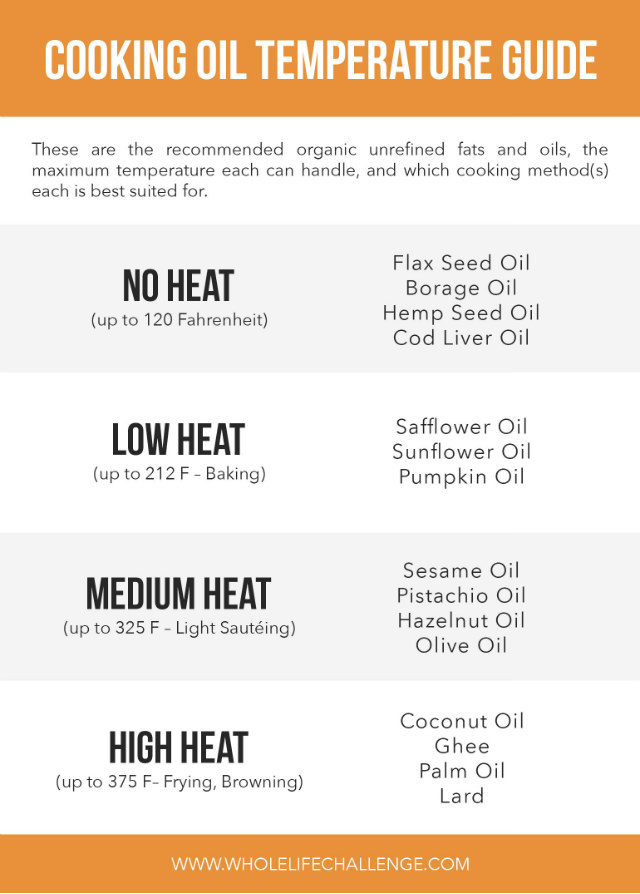
To summarize, oils such as flax seed oil and cod liver oil are very sensitive to heat and should only be used raw or as salad dressings. The best fats to use at higher temperatures are coconut, ghee, palm oil, and lard, as well as avocado oil, which is not on this list.
I personally think coconut oil is one of the best options for cooking at higher temperatures, but let’s dive into the most commonly used oils in more detail.
Olive Oil
So many of my clients come to me thinking olive oil is a healthy option for cooking, given that we have all been told it is a monounsaturated fat and good for our heart. And as you can see from the list above, olive oil can tolerate moderate heat, but definitely not high heat.
Olive oil is a wonderful fat I recommend to all my clients, but only to be drizzled on fresh with salads. That said, since olive oil can tolerate some heat, light sauteing is ok. For instance, you could saute your food with a little water or broth and add a drizzle of olive oil for texture and flavor. Lightly stir-frying vegetables is fine, too, such as sugar snap peas or broccolini that are only cooked for a minute so they are still fresh and crispy.
Heavy pan frying, grilling, and deep-frying involves temperatures that are too high for the safe use of olive oil so I suggest you switch to a fat that can tolerate higher heats such as coconut oil. If you consistently to cook at high heats with olive oil, you may be ingesting altered fat that can contribute to free radical damage and elevated LDL levels.
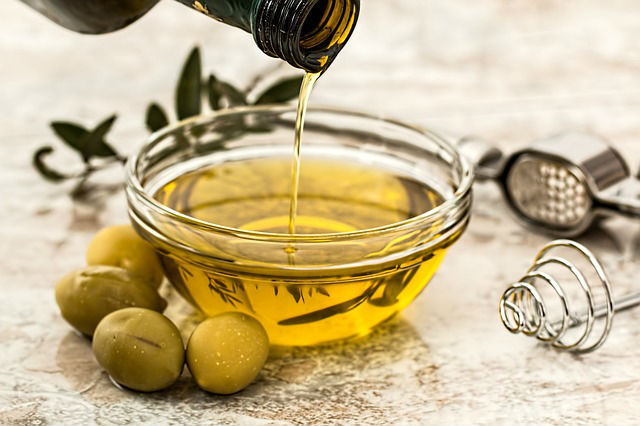
Olive oil can tolerate moderate heat, but not high heat.
Canola Oil
The majority of households and restaurants in the United States cook with canola oil. This is because canola oil is cheap and abundant and also because it has an ultra-high smoke point of about 405 degrees Fahrenheit. Its smoke point is higher than butter, coconut oil, olive oil, and ghee.
It is important to note that the more refined an oil is, the higher its smoking point. This is because free fatty acids, impurities, enzymes, and nutrients that can cause rancidity have all but been stripped away in the refinement process. It is this extreme refinement that gives canola oil its high tolerance to heat.
Canola oil comes from the rapeseed plant. In the past, rapeseed oil was considered inedible because of two compounds — erucic acid, which was linked to fibrous lesions of the heart, and glucosinolates, which made the oil taste very bitter. Therefore, the oil was used in manufacturing and for industrial purposes such as creating lubricants for machinery, fuels, paints, and plastics.
Modern canola oil came about back in the 1960s when a couple of scientists in Canada genetically modified it using techniques such as seed splitting to reduce the compounds that made it undesirable for human consumption. Since then it has undergone even more genetic modifications — for more than twenty years, Monsanto has manufactured rapeseeds that are genetically engineered to be resistant to the herbicides. If GMO foods concern you, you should be aware that 90% of the world’s canola crops are genetically modified.3
In addition, the standard industrialized process of extracting canola oil involves chemical additives such as hexane, high heat, processes to remove odor, and bleaching to make the final product look nice and light in color. So even though you think you are using a healthy option because canola itself contains low levels of saturated fat, high levels of monounsaturated fats, and high levels of polyunsaturated fats such as omega-3s, the intense refinement process converts these more sensitive healthier fats into trans fats anyway.
Check out this video of how canola oil is made:
Other Polyunsaturated Vegetable Oils
Soybean, sunflower, and safflower are other widely used oils, especially in commercial settings. These oils also have high smoking points ranging between 440 to 500 degrees Fahrenheit, with refined safflower being the highest.
Because these oils are so highly refined they aren’t healthy options for the same reasons as canola oil. One study analyzed the canola and soybean oils found on store shelves in the U.S. and found that 0.56 to 4.2% of the fatty acids in them were toxic trans fats.4 Again, these trans fats are produced because the high heat and chemicals used in the production process alters the more sensitive components of the fats in these oils.
So even though these oils have a higher smoke point, they aren’t healthy because they have been stripped of a lot of nutrients and contain trans fats due to the high level of refinement. If you do decide to consume canola oil and other vegetable oils, go with the organic, unrefined, cold pressed oil that has not undergone the same processing method even if that means the smoking point is lower.
Coconut Oil
Although there are a few different methods to manufacture coconut oil, cold pressed virgin coconut oil has become widely available. This extraction method retains the goodness and nutrients of the oil, and keeps it devoid of trans fats. I recommend cooking with organic cold-pressed virgin coconut oil because its smoke point is quite high at 375 degrees.
Coconut fat is unique in the sense that it is mostly a saturated fat, but from a vegan source. Coconut oil is comprised of mostly medium-chain fatty acids, which are processed by the body at a faster rate than plant-based long-chain fatty acids and are therefore are a good, available source of energy.
Coconut oil has also been shown to have myriad beneficial health properties:
- The medium-chain fatty acids help to promote HDL cholesterol (the good kind) and lower LDL cholesterol (the bad kind), which is good for the heart and can mitigate the risk of heart disease.
- It is anti-inflammatory, antifungal, and antibacterial.
- It has been shown to help with inflammation-based disorders such as arthritis and digestive issues such as IBS.
- It helps to boost the immune system, minimize gum disease and tooth decay, and is great for your skin. (I rub coconut oil all over my skin while I am cooking with it!)
Not to mention, coconut oil tastes amazing and adds a slightly sweet and nutty flavor to any dish.
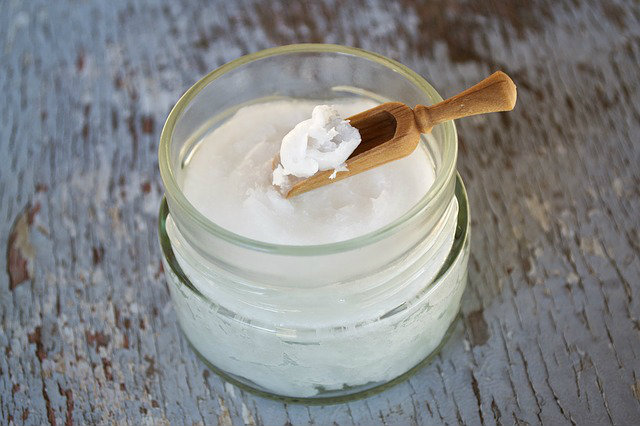
Organic cold-pressed virgin coconut oil has a smoke point of 375 degrees.
Avocado Oil
Another oil that is gaining popularity is avocado oil. Avocado oil is nutrient rich like flaxseed oil, but unlike the other healthy non-refined vegetable oils, avocado oil can tolerate higher heats.
Avocado oil is much like olive oil in that it can be enjoyed raw when sprinkled on salads and it can also be used for light cooking since the smoking point of extra virgin cold-pressed avocado oil is around 210 degrees Fahrenheit for the more refined version can tolerate heats up to 375 degrees Fahrenheit. I recommend you use avocado oil for light sauteing just like olive oil.
Avocado oil is predominantly a monounsaturated fat. It is high in vitamin E and has been shown to lower cholesterol and inflammation. The monounsaturated fat from avocado is good for your heart health.
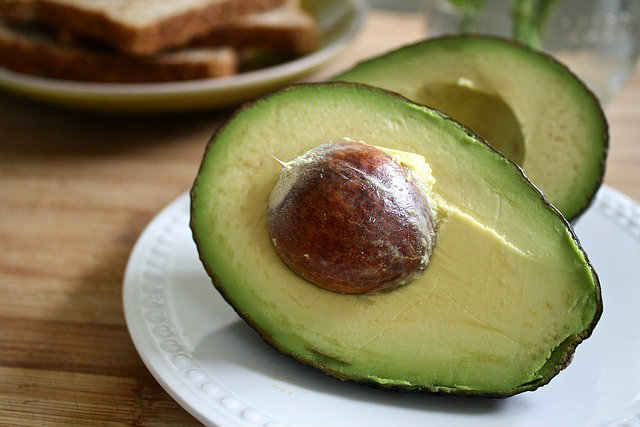
For healthy recipes, grab my 7-day meal plan: Spring into Summer eBook.
Animal Fats
Butter, ghee, and lard are all animal fats and contain high levels of saturated fats. Although there is still a lot of stigma to saturated fats, if we were to choose the lesser of two evils, these fats are way better for your health than refined vegetable oils such as canola oil. This is because these fats are devoid of trans fats and are still comparatively in their natural states so your body is properly equipped to process them.
If you choose to use animal fats, be aware there are refined options, such as the lard found in cans at the supermarket, that have been hydrogenated to increase their shelf life, but generally speaking they are still on the more natural end of the scale. Look for “leaf lard,” as this is made from the highest quality fat from the pig and tends to be less processed. When it comes to butter, make sure you opt for grass-fed butter.
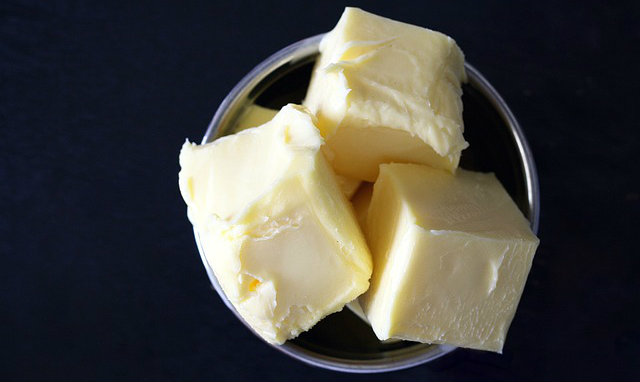
When it comes to butter, make sure you opt for grass-fed.
Summary: How to Cook with Fats and Oils
If all this seems a bit confusing, I can simplify this really easily for you:
- Do most of your cooking with coconut oil.
- Sprinkle olive oil on your salads.
- Avoid canola oil and other highly refined and processed vegetable oils unless you plan to do some seriously heavy cooking on high heat or deep frying. (But if you plan on deep frying your food, you aren’t really making healthy choices, are you?)
- Don’t be afraid of fats derived from animal sources such as ghee, butter, and lard. They aren’t as bad for you as mainstream thought would have you believe.
If you just stick to cooking with olive oil and coconut oil, you should buy organic, cold-pressed virgin oils to ensure they are not refined and do not contain trans fats. Generally speaking, the more expensive and less processed the oil is, the better it is for you. All oils should be stored in a cool dark place away from the hot stove and away from direct sunlight to ensure longevity and that the oils retain their nutrients and flavors.
And if you haven’t cooked with coconut oil, have fun — it adds a wonderful flavor and is simple to use.
References:
1. N. Khan-Merchant et al, “Oxidized fatty acids promote atherosclerosis only in the presence of dietary cholesterol in low-density lipoprotein receptor knockout mice.” J Nutr. 2002 Nov;132(11):3256-62.
2. Paul Chek, How to Eat, Move and Be Healthy! Published by C.H.E.K Institute, San Diego, USA, 2004 . Page 73
3. Kris Gunnars BSc, “Canola Oil – Good or Bad?” Authority Nutrition.
4. Sean O’Keef, “Level of Trans Geometrical Isomers of Essential Fatty Acids in some Unhydrogenated US Vegetable oils,” Wiley Online Library, Published 1994.
5. Dr. Axe, “Benefits Of Coconut Oil.”
